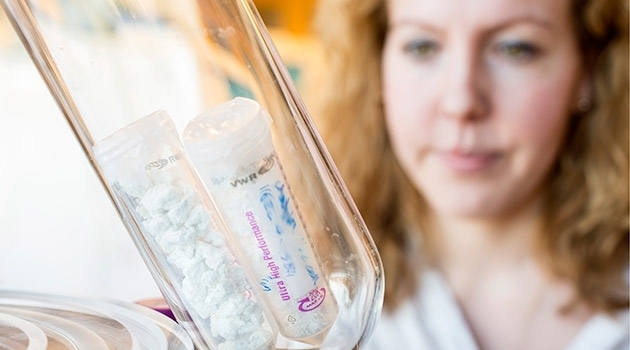The material with many properties
The material Upsalite was discovered by Maria Strømme’s research group and has properties that have attracted great international attention. It inhibits the growth of bacteria, for example, and is extremely good at absorbing moisture. A company has been formed in which entrepreneurs and researchers work side by side on various applications of the material.
It has so far been demonstrated that the porous material can be used to improve the release of poorly soluble drugs in the body and for various on-skin applications. The material can also be used not only to distribute pleasant fragrances, but also to remove unwanted odours, such as in fresh fish packaging. The humidity in sensitive electronics can be checked and environmental toxins can be filtered from wastewater. The tale of Upsalite is an unlikely success story, but involves many years of pure research.
“Our goal from the beginning”, says Maria Strømme, Professor of Nanotechnology, “was to solve a big problem in the pharmaceutical industry, namely that many of the drugs now being developed have poor solubility. They tend to form crystals, which are difficult to dissolve in the gastrointestinal tract.”
After experiments with calcium carbonate, which wasn’t stable enough, they began to work with magnesium carbonate, which was also approved for pharmaceutical products. The idea was to create a porous magnesium carbonate with extremely small, nano-sized pores.
“We knew that when drug molecules are forced into the pores,” says Strømme, “they can’t form crystals and instead remain in a disordered form that allows the body to absorb them in the stomach and intestines.”
But although the solution was within reach, they couldn’t quite grasp it. Attempt after attempt failed. Until researcher Johan Gómez de la Torre (né Forsgren) started a material synthesis process on a Thursday, fell ill on Friday, forgot to ask someone to stop the process and then didn’t return to it until Monday.
“That’s when he saw that something had happened,” says Strømme. “The material mixture had changed character and after drying, we got the exact porous material we wanted. We were blown away.”
The research team was no less excited when they realised that researchers had been trying to create a similar material since the beginning of the 20th century. Several articles and even a Russian PhD thesis from the 1960s had concluded that the synthesis Strømme’s research team had just managed to do was impossible.
“That was when we realised that we’d better prepare ourselves to have our findings contested,” says Strømme. “We have never analysed samples so carefully! By December 2012, we were sure and could patent the material. In the summer of 2013, we published the news in a scientific journal.”
The media attention was immediate and Google hits for the word ‘Upsalite’, which the researchers had named the material, went from zero to five hundred thousand in just a couple of weeks. What attracted the most media attention was that the material proved to be extremely good at absorbing moisture, which in itself was a fortunate side effect. The goal from the beginning was to stabilise drug molecules.
company and Maria Strømme leads the
research team.
It was now clear that the results had market potential and the company Disruptive Materials AB was formed to commercialise the discovery of Upsalite. Sara Frykstrand, who was a doctoral student when Upsalite was discovered, is one of the company’s co-founders.
“We’re in a very exciting phase and of course it feels overwhelming at times,” says Frykstrand. “But I take it one step at a time and focus on my daily work – that’s how I function.”
Today, Frykstrand spends 70 per cent of her working hours at the company and 30 per cent as a researcher and has become accustomed to combining the roles. Seven researchers and eleven entrepreneurs work together on applications such as optimising Upsalite for drug delivery in medication to treat conditions including rheumatoid arthritis, HIV symptoms and cancer.
“But sometimes you have to watch what you say,” says Frykstrand. “Researchers produce results by publishing, so the company can’t go public with secret information without first consulting the research team.”
For Maria Strømme, this close link between pure research, applied research and commercialisation is an effective trio that creates added value for Uppsala University and society as a whole.
Is there any risk that researchers will only focus on research that can be applied and neglect ‘impossible’ projects?
“Interesting question,” says Strømme, “but all my experience tells me that when you let an application drive the project as we have done with Upsalite, it means that your pure research has to be excellent. This has been my experience from project to project, from patent to patent.”
Frykstrand agrees.
“Once we’d made the discovery, I devoted an entire year just to pure research in order to understand all the phases and interphases in the Upsalite synthesis.”
Henrik Möller

